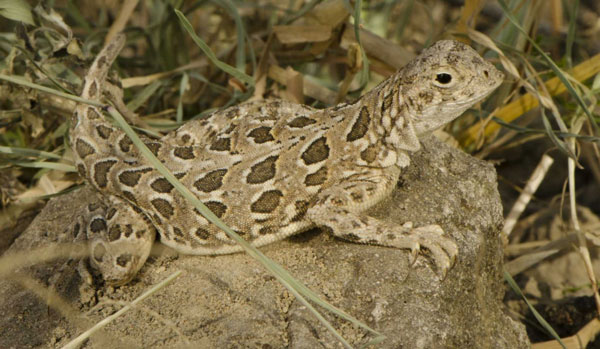The spot-tailed earless lizard, native to South Texas, could be the next Texas lizard that may or may not be placed on the Endangered Species List, as
The spot-tailed earless lizard, native to South Texas, could be the next Texas lizard that may or may not be placed on the Endangered Species List, as U.S. Fish and Wildlife noted in 2011 that it may warrant endangered or threatened protections. But the lizard’s habitat is apparently smack dab in the middle of large areas of the Eagle Ford Shale, which is close to producing 1 million barrels of oil per day.
Read More
Texas Plan To Protect Dunes Sagebrush Lizard Never Released To Public
The comments for the listing of this lizard, unlike the dunes sagebrush lizard, numbered just 15 during the 2011 comment period, according to Express News Texas and one of those comments was submitted twice. So why hardly a peep with regard to the potential listing of this lizard? A lot may have to do with the inability of researchers to even locate the reptile. There is not a whole lot of information regarding its lifespan or its lifestyle.

Texas Parks and Wildlife Department
The spot-tailed earless lizard's likely habitat is the Eagle Ford Shale region of south Texas.
Scientists have no idea what it eats and where exactly it lives. Scientists do know that there are two species, the southern spot-tailed earless lizard (Holbrookia lacerata subcaudalis) of South Texas and Mexico, and northern spot-tailed earless lizard (Holbrookia lacerata lacerata) found throughout the state’s Edwards Plateau. While the northern lizard can easily be found, it is the southern lizard that is difficult to locate. In 11 years of field work, researchers have not found a single specimen, dead or alive. According to the news report, an aircraft mechanic recently took a photo of a southern spot-tailed earless lizard on the Laughlin AFB and sent it to a horned lizard specialist who identified it as a southern spot-tailed earless lizard.
Without any research on the animal, the Fish and Wildlife Service has several options. They can list the animal as threatened or endangered, the can do nothing and keep the reptile on the candidate list, or say that listing the lizard is warranted but list other species as higher in priority.
Another issue is that scientists don’t know if oil exploration in the area will have any impact on the lizard. What the scientists do know is that the lizard likes open areas and bare ground, which for the most part fits an oil and gas field. If the lizard’s habitat becomes more widely known and is found to be in danger, the likely outcome between the USFWS and the oils industry would be a conservation agreement that would protect the habitat and allow for gas and oil development. This is the scheme that was worked out with regard to the dunes sagebrush lizard. That agreement was confirmed October 2 when a U.S. district judge threw out a lawsuit against USFWS that claimed the conservation efforts was wrong and won’t ensure long term survival of the species.


